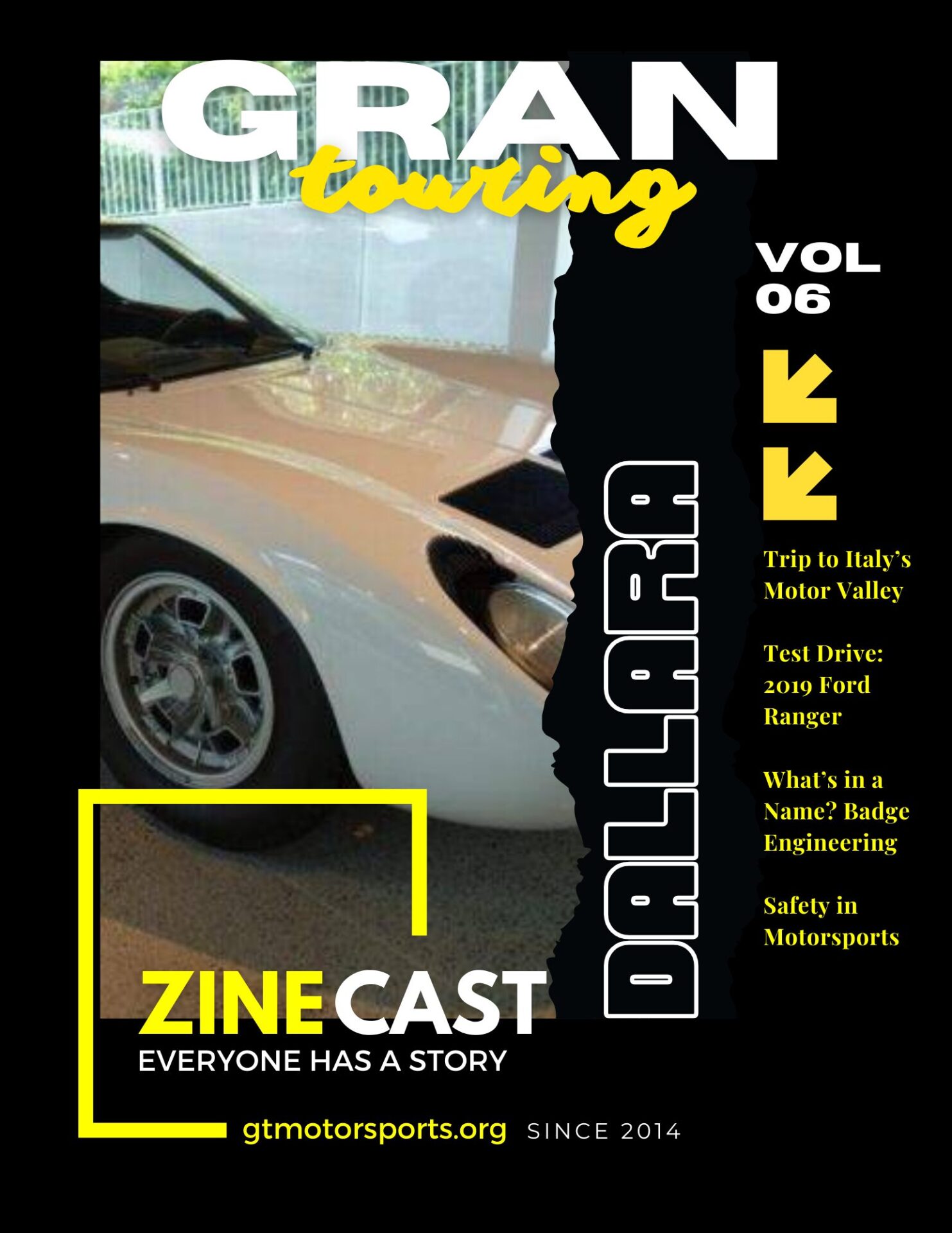I have never been less excited to test drive a car than I was on my recent trip to San Antonio, TX. I had psyched myself up… gettin’ a Challenger, I want a Challenger, HEMI!, gonna be awesome! #sendit! – With none available on the lot and utterly heartbroken, I was handed the keys to a brand new…
FORD.FUSION.HYBRID.
Grrrrrrreat! – And when I say new – I mean new-new – it had 24 miles on the odometer! Exciting? Inspiring? Something you wanted to spend your spare cycles reading about, right!? Probably not, but hear me out. Normally, I wouldn’t bother everyone reviewing something a mundane as your run-of-the-mill “rental turd” but by now, you’ve probably heard the news: earlier this year Ford Motor Co. announced that it had decided to discontinue any vehicle in its line up that isn’t a Truck or the Mustang.

I’ve never spent any real time with any of the newer Ford models outside of the Mustang and the Focus RS, let alone Hybrids of any brand. On a theoretical level, there is nothing inherently wrong with these new “green technologies.” I can appreciate the engineering leaps that were taken from the days of the GM EV-1, Tesla Roadster, and others to get them to where they are today. But “green-tech” is not something I tend to geek out over. Spending an entire week with the Fusion would leave some lasting first impressions and hopefully prove to be an educational experience.
But before everyone clicks away screaming Blasphemer! It’s Voodoo, pure Witch-craft! I’m not going to waste your precious attention on a campaign of “electric vs petrol” but rather spend a moment talking about a car that is about to become extinct.
The Geeky Stuff
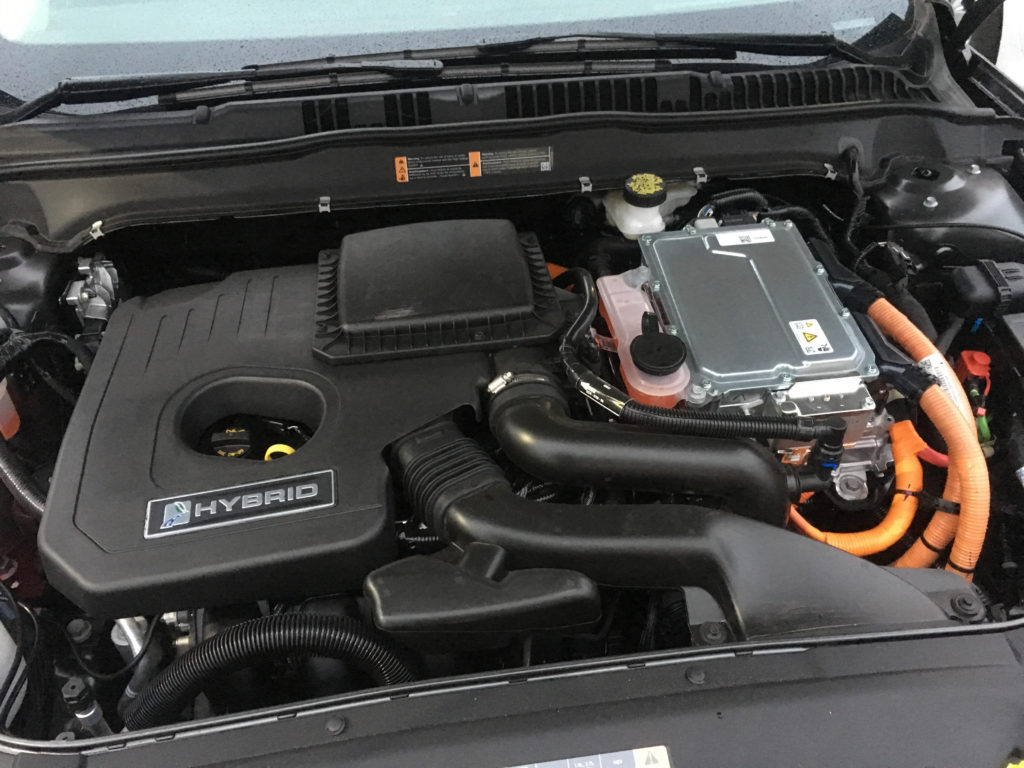
The Fusion Hybrid comes equipped with a 2.0L iVCT Atkinson-cycle I-4 engine and 88kw electric motor, featuring electronically controlled continuously variable transmission (eCVT). Whaaa? Whooo? Where? #blindedwithscience. #turboencabulator.
The Fusion boasts an all-electric top speed of 85 mph and 21-mile range on a full charge. And the MPG figures? – Well… we’ll talk more about fuel economy numbers later in this article. Meanwhile, the Jean-Luc Picard inspired “ENGAGE” menu (below) is the only useful feedback from the vehicle outside of the Speedometer on the dash.
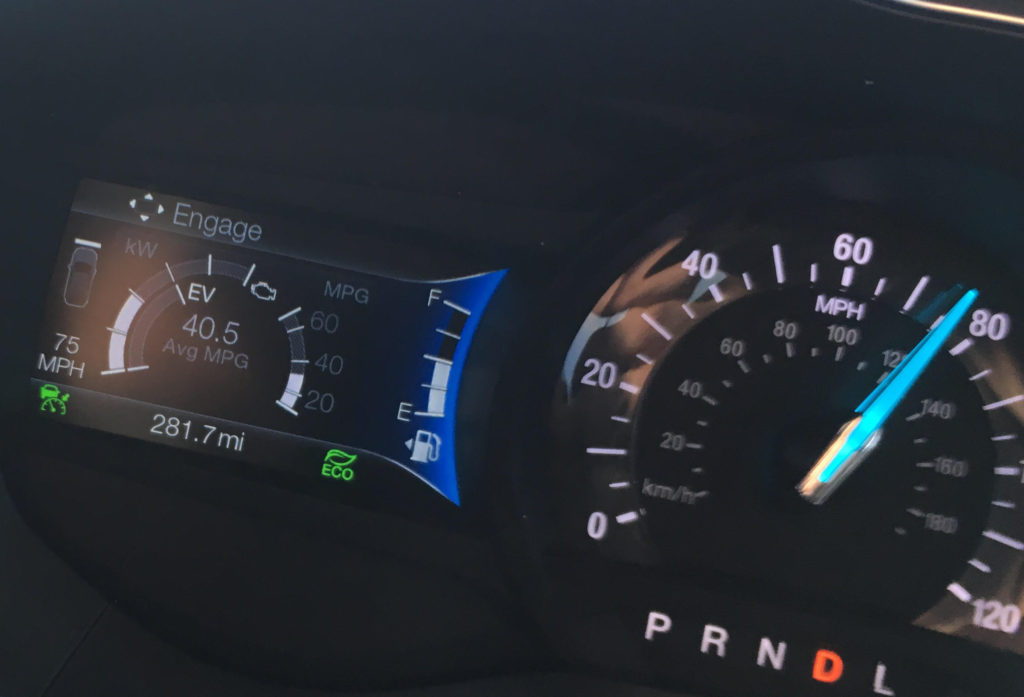
Since there is no tachometer and the motor is utterly silent unless you’re ringing its neck, the “Engage” menu acts as your power monitor and rev-counter. From what I could gather, each tic-mark on the petrol side was about 1000 rpm, which meant a low red-line of around 5k. The electric motor can assist the gas engine up to about 70% (3000 rpm) when you put the hammer down. Again, rough calculations put this engine at a cruise RPM of just under 2k at 75 mph (which is the speed limit on I-10 West in TX) which makes for a pretty decent final drive on this 6-speed automatic.
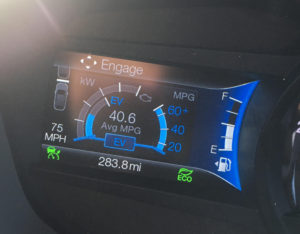
When EV is 100% engaged, the menu turns blue with a small “EV” in the center and gives you a “real time” MPG metric. The real-time MPG stuff is a bit of a laugh in my opinion, but I will say there is very little latency in the UI (user interface) when the menu is switching between readouts.
Driveability
From a purely performance perspective – the Fusion Hybrid is … “a gutless wonder.”
Someone wiser than me once said: “Horsepower is what you hear, and torque is what you feel” – none of which applies to this car. When solely propelled by the electric motor (at lower speeds) the vehicle feels like a golf cart. When the gas engine is 100% active the Mazda 2.0L is too weak to get out of its own way. Thankfully, Ford has effectively leveraged the electric motor to assist the gas engine on long hills, lane changes, etc., giving the driver a sensation similar to “turbo torque.” The system switches between Gas and Electric seamlessly, and the entire engine bay is generally so quiet you can’t tell when the motor is turning on/off or transitioning.
During the long drive from Houston to San Antonio, I took the opportunity to test out another feature of the Fusion: ACC (Adaptive Cruise Control). Generally, with automatics I’ve always felt that unless you had “decent power” standard cruise control was always an exercise in futility. The cruise system waits too long to adapt speed, you end up feverishly tapping buttons to get it to react and there is always a delay in the transmission kick down, it kicks down too far and then the engine starts to scream to maintain speed. In my opinion, it makes for a very obnoxious ride.
ACC is a feature that I have on my daily-driver but have never used. Being “old school” and hearing some horror stories about ACC systems, I’ve never wanted to try it. Since my vehicle lets me disable ACC and use standard cruise, I’ve opted for that. But since this wasn’t my car … #sendit #rentalinsurance.
Ford’s ACC gives you 3 “following distance” settings, each measuring approximately 1 car length (plus/minus a couple feet). I choose to use the “1” option to try and keep up with the flow of traffic and make my test more realistic. The ACC works for the average driver but it also has some “unusual side effects”:
- ACC will come to a complete stop if the car in front of you does as well, and it will take off again when they do… Just don’t forget that when you come to a stop light/sign you might want to turn off the ACC else the car tries to pull out into traffic. OOPS!
- Situational awareness is key with the ACC. If you’re not paying attention you will follow the car in front… for a long time… at 20 miles under the limit. Grrrr.
- If a car cuts in front of you, the accident awareness system kicks in and the system puts on the breaks – hard! One question I still don’t have an answer for: If the car is stopping for you, are your brake lights on? – Always remember to check your mirrors!
- Lane changes. If you come up on a slower vehicle and you’re within range the ACC will slow the car down, and when you stick your nose out to pass there is a delay before the ACC starts accelerating, which means, there best not be anyone making an approach in the left lane or they will have to slow down to avoid you.
Overall, I found the ACC to be more stressful than standard cruise control. I felt as though I needed to babysit it more and that took focus away from the road. Using standard cruise control, I could just pay attention and override the system with either the gas or the brakes. If this is any indication of what “self-driving” cars will be like, I’ve decided … I just don’t feel like it is something for me.
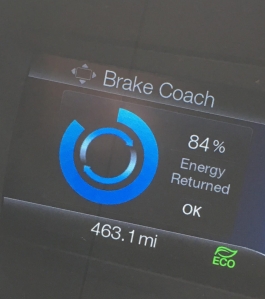
And the last bit of tech that influences the driveability is “the Coach” (above). Sadly, the Coach isn’t voiced by Craig T. Nelson, but the system is supposed to help you learn how to drive your Hybrid more efficiently. I have to admit that driving a Hybrid is a very different experience than a petrol car, there is a bit of a disconnect from you and the engine bay. The braking coach was especially entertaining in the beginning, when I learned that very long “limousine stops” would gain you higher percentages (points!) than hard stops. I tested this out and a panic stop from higher speed would net you about 25% energy return even though you were using “more brakes.” Double braking is also a no-no. At first it was a game: how many times can I get 90+%? Can I get to 100%? – but like anything new, the shiny object becomes dull and you move on. #gimmick. Note: You *must* come to a complete stop for the Coach to register a value!
Creature Comforts
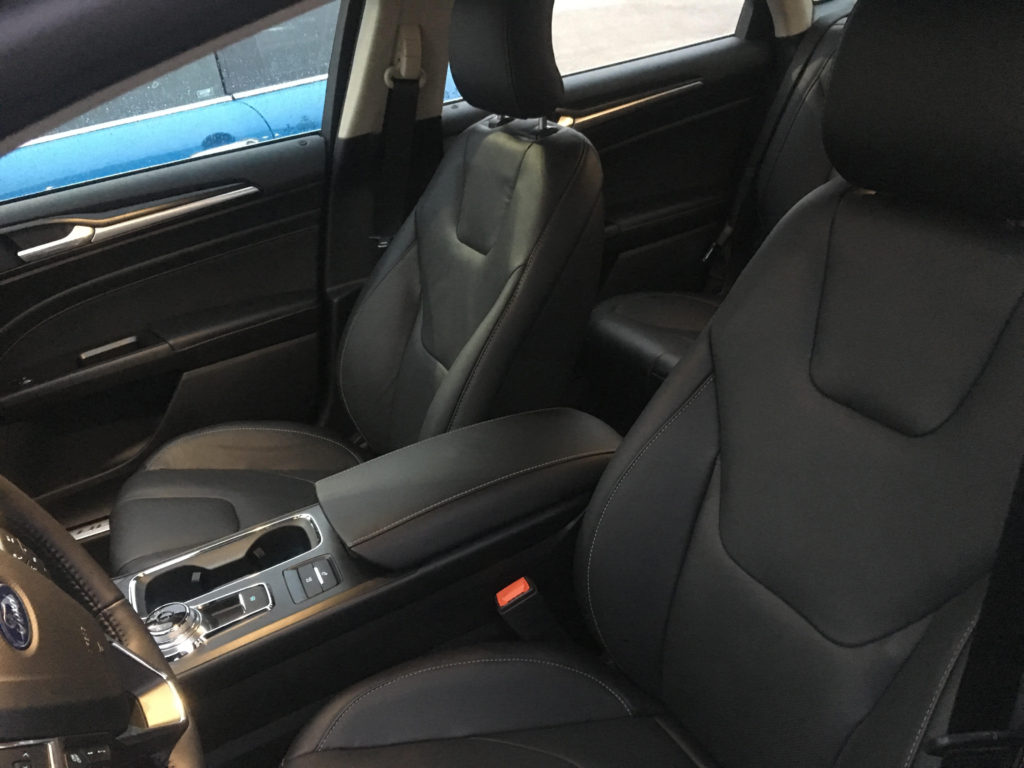
The Fusion interior is pretty well sorted and spacious. Nothing is really out of place where you say to yourself “why the heck did they put *that* >>> there?” It has a familiar quasi-european-econo feel to it, but borrows many of the angular cues and coloring from the Focus line. Some pieces of the interior – though not important to the operation of the car – feel like Ford was trying too hard to make it “different” when they didn’t need to. If you get the chance to look at the upper part of the dash in person, you’ll know exactly what I am talking about. I much prefer smooth lines, and honestly thought the center arm rest was one of the nicest accent pieces in the car (above).
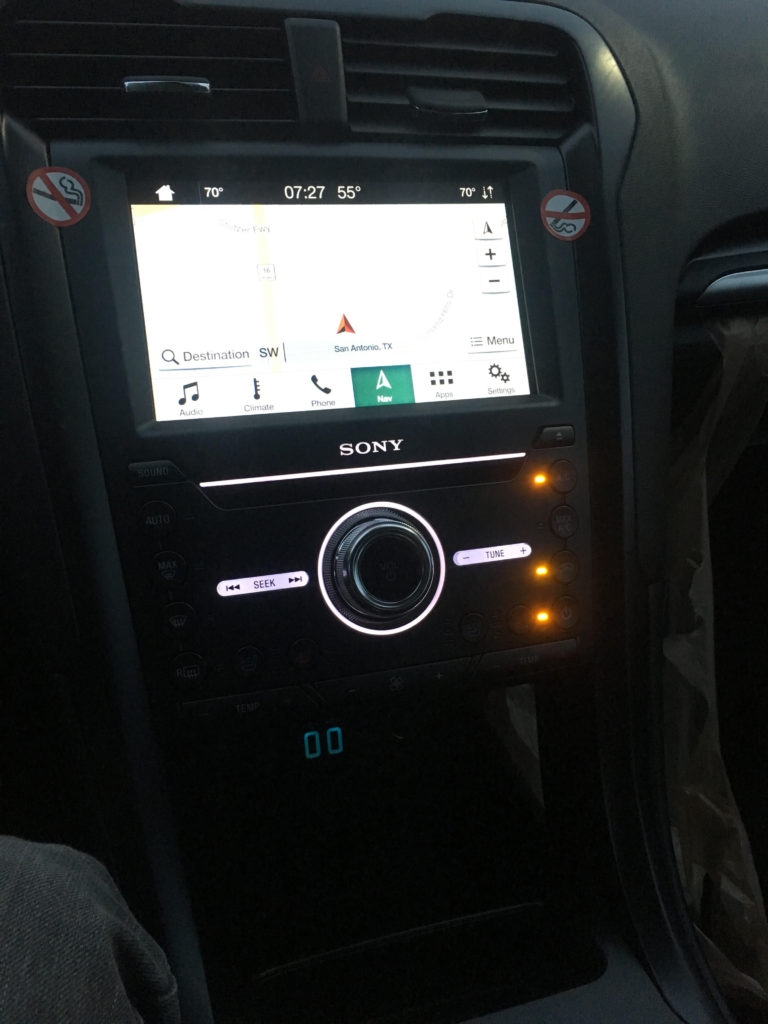
I have never been one to get excited about Stereo systems or MFI (multi-function interfaces) in vehicles but they are now a big part of the design of modern interiors. Coming from a vehicle equipped with uConnect (voted one of the best MFIs available) it was hard to get adjusted to the Ford Sync system. Others might argue otherwise, but a big let down for me was the recent update to the Sync. Ford broke it’s relationship with Microsoft, and in doing so broke their MFI. The stereo is by Sony which sounds great, and is quite on par with other manufacturers who offer Bose or Hardon-Karmon systems in their vehicles. Sadly, the entire interface for the Sync looks and feels like a Sony blue-ray player UI from 2009. The coloring is bland and some of the menu navigation is clunky.

Depending on how you use this car, this next part might be a deal breaker for you. Using the graphic above from Fords website to help illustrate my point, you will notice that the battery system for the Hybrid was retro-fitted to an existing chassis design. This design already accommodates both a FWD and AWD drivetrain which robs the vehicle of valuable cargo space. The addition of the batteries creates a rather tall shelf in the trunk. Placing a medium-sized check-luggage and a backpack in the trunk filled up the entire space. You can place some smaller Amazon boxes on top of the battery shelf if you need to but that’s going to be about it.
Final Thoughts

The Good
- I am always pleased when a manufacturer decides to just create an “engine swap” chassis instead of making their new tech vehicle look like something out of Minority Report (ie: Prius, Tesla 3, etc) – the Fusion is a typical sedan which is available in other configurations like a 2.5L 4-cylinder and a V6 option instead of the Hybrid – and lets not forget FWD and AWD variants.
- The Fusion, though not as pretty as the recently departed Chrysler 200, takes it’s VW Passat-CC inspired low roof line and places the front seats low enough that it has good head height for taller folks along with great visibility and not much in the way of blind spots.
- Although the seats in my rental car were (p)leather with some bolstering giving them a “sporty” look, they proved to be quite comfortable on the long drive.
- I have never been a fan of CVT transmissions, they always give you a “clutch is slipping” sensation. The CVT in the Fusion is surprisingly smooth.
- I put about 800 miles on the Fusion after nearly a week with the car, and spent a total of $23 on fuel.
- Huge incentives from Ford if you can grab one of these vehicles before they are gone.
The Meh…
- There is a definite disconnect between the “go pedal” and the engine compartment. Considering one pedal is controlling two different types of power supplies, it’s something you definitely have to get used to.
- Lots of little tech-gimmicks which you can take/leave/trust, that’s entirely up to you.
- Very small fuel tank, about 12 gallons. 21 miles of range on battery only.
- On paper the MPG/eMPG numbers make the Fusion look amazing “43 city/41 hwy/42 combined mpg – 104 city/ 91 hwy/ 97 combined MPGe” – The reality is mid-to-high 40s as a cumulative average city/hwy is definitely achievable.
- Even though the Fusion has two control stalks (one for wipers/cruise and the other for turn signals) there placement seems to be more for someone that drives with their hands at 10 & 2, making them out of place and harder to reach if you drive with your hands lower on the steering wheel.
- Honestly, the handling isn’t anything to write home about, the car feels heavy and the suspension is soft.
- The brakes are good, but I think people might be encouraged to overuse them to get the 100% recharge return from the Coach. This equates to wearing out the pads more quickly. You have to find a balance in your driving so you can regen some power without driving like your Grandpa, else you’ll drain the batteries in no time (in EV only mode).
- Merging is an adventure. If I didn’t know any better, I would say the Fusion Hybrid suffers from “Turbo Lag” – and much of it goes back to “throttle application.” You can make the Fusion hit a respectable 0-60 in 8.5 seconds if you can get the timing right: EV first, then Fuel then assist from the EV = 8.5.
- The trunk is oddly shaped because the batteries were retro-fitted into a chassis that wasn’t originally a hybrid vehicle. It looses 4 cubic feet of space over regular Fusion thanks to the batteries.
- Production of the Fusion stops in 2019. Some people might be concerned about parts suddenly becoming unavailable, more than likely Ford will stock parts for the Fusion for another decade plus.
If you had asked me before this trip, the sheer thought of driving a Hybrid … gaak! – I seem to have the same adverse reaction as people do to the word “Moist” – ugh!
All kidding aside, being a long time Automotive Enthusiast, cherishing every drop of dinosaur blood I have burned over the years, the idea of driving – let alone owning – a Hybrid was something I wasn’t ever considering. But at the end of my journey, I came to like the Fusion – even with all its quirks – and had to appreciate it for what it is or maybe what it was. It’s a balance between size, comfort, and economy and makes for a great alternative for people just looking for something to commute in. #merrymotoring.



